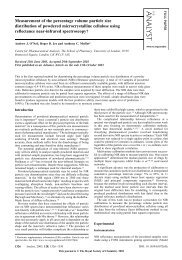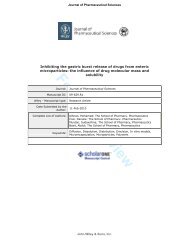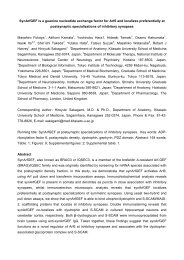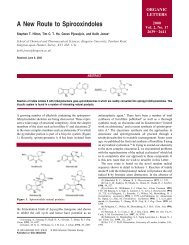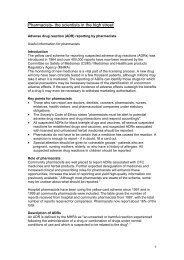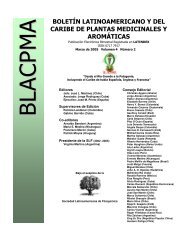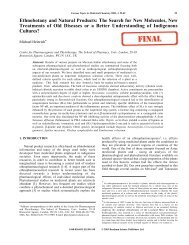Inhaler technique in Turkish people with poor English: a case of ...
Inhaler technique in Turkish people with poor English: a case of ...
Inhaler technique in Turkish people with poor English: a case of ...
You also want an ePaper? Increase the reach of your titles
YUMPU automatically turns print PDFs into web optimized ePapers that Google loves.
Pharm World Sci (2006) 28:107–114 109<br />
Table 1 Information po<strong>in</strong>ts<br />
h Take cover <strong>of</strong>f and check the mouthpiece is clean<br />
h Shake the <strong>in</strong>haler well<br />
h Hold the <strong>in</strong>haler upright <strong>with</strong> thumb on the base, below<br />
the mouthpiece<br />
h Breathe out normally<br />
h Close lips firmly around the mouthpiece<br />
h Start to breathe <strong>in</strong>, then press down on top <strong>of</strong> the <strong>in</strong>haler.<br />
Keep on breath<strong>in</strong>g <strong>in</strong> steadily and deeply<br />
h Take <strong>in</strong>haler from mouth<br />
h Hold breath for as long as is comfortable<br />
successful; <strong>of</strong> 100 <strong>in</strong>vited to attend only 10<br />
accepted. A ‘‘snowball’’ convenience sampl<strong>in</strong>g<br />
method was therefore used, us<strong>in</strong>g contacts <strong>in</strong><br />
social clubs and <strong>in</strong>formal networks <strong>in</strong> Tower<br />
Hamlets and Camden. Subjects were assessed<br />
ma<strong>in</strong>ly <strong>in</strong> their own homes. Written and spoken<br />
skills <strong>in</strong> <strong>English</strong> and <strong>Turkish</strong> were assessed us<strong>in</strong>g a<br />
language pr<strong>of</strong>iciency test devised by the Language<br />
Department at K<strong>in</strong>g’s College London.<br />
This <strong>in</strong>cluded be<strong>in</strong>g asked to read and expla<strong>in</strong> an<br />
<strong>English</strong> phrase and to answer the question: ‘‘what<br />
medic<strong>in</strong>es do you have now?’’<br />
Table 2 shows population data on literacy and<br />
birthplace for the three study areas.<br />
Study procedure<br />
Sessions for the EP group were run by a <strong>Turkish</strong><br />
pharmacist (ZD) who acted as both researcher<br />
and translator. The procedure for the <strong>English</strong><br />
group has been reported elsewhere [12]. Demographic<br />
and treatment-related <strong>in</strong>formation (see<br />
Table 3) was collected before each patient was<br />
Table 2 Area demography<br />
Area Total<br />
population<br />
% born outside<br />
UK/Eire<br />
Har<strong>in</strong>gey 216,507 34.4% 5.3<br />
Tower Hamlets 196,106 33.4% 10.6<br />
Camden 198,020 33.6% 5.1<br />
London 7,172,091 24.9% 4.9<br />
England 49,138,831 8.3% 4.0<br />
% very low<br />
literacy*<br />
*Data from Census 2001 and Basic Skills Agency<br />
Very low literacy: difficulties <strong>in</strong> cop<strong>in</strong>g <strong>with</strong> everyday<br />
read<strong>in</strong>g and numbers; need <strong>in</strong>tensive help to reach<br />
m<strong>in</strong>imum standard. Includes <strong>people</strong> <strong>with</strong> learn<strong>in</strong>g<br />
difficulties<br />
assessed. As the time per patient was limited, only<br />
basic <strong>in</strong>formation was collected. Participants were<br />
not asked about their educational history, or for<br />
details <strong>of</strong> their current job. Access to GP records<br />
was only possible for the EP group. Asthma<br />
severity <strong>in</strong> the two groups could therefore not be<br />
compared.<br />
Recruits gave written consent for a videotape<br />
to be made. They then demonstrated to the<br />
camera the use <strong>of</strong> the MDI, <strong>with</strong>out a spacer<br />
device, us<strong>in</strong>g a placebo canister placed <strong>in</strong>to their<br />
own holder. Technique was demonstrated twice;<br />
before and after view<strong>in</strong>g <strong>in</strong>formation.<br />
Patients were allowed to use the program, or<br />
study the leaflet for as long as they wished before<br />
repeat<strong>in</strong>g the demonstration. The researcher/<br />
translator identified areas where <strong>technique</strong> could<br />
be improved, then spent up to 15 m<strong>in</strong> discuss<strong>in</strong>g<br />
this <strong>with</strong> the user. A f<strong>in</strong>al video record<strong>in</strong>g was<br />
then made.<br />
This allowed the effect <strong>of</strong> the <strong>in</strong>formation<br />
alone to be separated from the comb<strong>in</strong>ed effect <strong>of</strong><br />
PIL + translator support.<br />
Assessment <strong>of</strong> <strong>in</strong>haler <strong>technique</strong><br />
Videotaped demonstrations were digitised, compressed<br />
to MPEG format and transferred to<br />
CD-ROM. They were subsequently assessed by<br />
two pharmacists <strong>with</strong> experience <strong>in</strong> respiratory<br />
medic<strong>in</strong>e. These assessors did not attend experimental<br />
sessions and had no contact <strong>with</strong> patient<br />
volunteers. They were therefore, bl<strong>in</strong>d as to the<br />
<strong>in</strong>formation format, but not as to the patient’s<br />
probable ethnic orig<strong>in</strong>.<br />
First, the assessors were asked to play the clip<br />
through <strong>with</strong>out stopp<strong>in</strong>g and to rate global<br />
<strong>technique</strong> as <strong>poor</strong>, adequate or good. This would<br />
probably approximate to a ‘‘quick check’’ <strong>of</strong><br />
<strong>technique</strong> performed <strong>in</strong> the cl<strong>in</strong>ic. Poor <strong>technique</strong><br />
was def<strong>in</strong>ed as any <strong>of</strong> the follow<strong>in</strong>g:<br />
– press<strong>in</strong>g the canister before <strong>in</strong>spiration<br />
– visible ‘‘mist’’ escap<strong>in</strong>g from the mouth<br />
– no significant <strong>in</strong>halation observed<br />
– not releas<strong>in</strong>g a dose at all<br />
Assessors then assessed <strong>technique</strong> <strong>in</strong> detail us<strong>in</strong>g<br />
a checklist. The <strong>in</strong>dividual steps shown <strong>in</strong><br />
Table 1 were scored as correct or <strong>in</strong>correct.<br />
123



